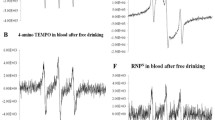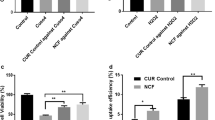Abstract
Alzheimer's disease (AD) is a fatal neurological illness that worsens with time. Preventing the aggregate formation of amyloid beta protein is a promising approach to treat Alzheimer's disease. This article describes an amiable procedure for the synthesis of Olesoxime-Resveratrol (OLX-RSV) encapsulated in exosomes. By suppressing Aβ1-42 aggregation and crossing the blood–brain barrier also known as BBB after intravenous treatment without resulting in any discernible damage, the nanocomposite demonstrated good biocompatibility. A variety of characterization technique including particle size, TEM, and in vitro drug release experiments, were used to characterize the exosomes. Human Neuroblastoma (SHSY5Y) cells were used to test the cytotoxicity and viability of cells of the formulation using the Cell Counting Kit-8 assay. The prepared OLX-RSV-loaded exosomes were tested for their ability to suppress Aβ1-42 in SHSY5Y Cells by analyzing the amyloid samples using CD spectra. The effects of apoptosis on Human neuroblastoma cells were studied using cytofluorometry. The parameters of SOD, caspase-3 and the ability to scavenge reactive oxygen species (ROS) were also evaluated. The behavioral outcomes of Morris water maze test demonstrated that OLX-RSV-loaded exosomes significantly enhanced the APP/PS1 mice's capacity to learn and remember spatial cues. Therefore, we hypothesized that OLX-RSV-loaded exosomes could be a useful and efficient method in the treatment of AD.












Similar content being viewed by others
Data availability
Not applicable.
References
Al-Edresi S, Alsalahat I, Freeman S, Aojula H, Penny J (2020) RSV-mediated cleavage of amyloid β1–42 peptide: potential relevance to Alzheimer’s disease. Neurobiol Aging 1(94):24–33
Babalola JA, Lang M, George M, Stracke A, Tam-Amersdorfer C, Itxaso I, Lucija D, Tadic J, Schilcher I, Loeffler T, Flunkert S (2023) Astaxanthin enhances autophagy, amyloid beta clearance and exerts anti-inflammatory effects in in vitro models of Alzheimer’s disease-related blood brain barrier dysfunction and inflammation. Brain Res 15(1819):148518
Bagno L, Hatzistergos KE, Balkan W, Hare JM (2018) Mesenchymal stem cell-based therapy for cardiovascular disease: progress and challenges. Mol Ther 26(7):1610–1623
Bilal M, Barani M, Sabir F, Rahdar A, Kyzas GZ (2020) Nanomaterials for the treatment and diagnosis of Alzheimer’s disease: an overview. NanoImpact 1(20):100251
Bordet T, Buisson B, Michaud M, Abitbol JL, Marchand F, Grist J, Andriambeloson E, Malcangio M, Pruss RM (2008) Specific Antinociceptive Activity of Cholest-4-en-3-one Oxime (TRO19622) in Experimental Models of Painful Diabetic and Chemotherapy-Induced Neuropathy. J Pharmacol Exp Ther 326(2):623–632
Bordet T, Buisson B, Michaud M, Drouot C, Galea P, Delaage P, Akentieva NP, Evers AS, Covey DF, Ostuni MA, Lacapere JJ, Massaad C, Schumacher M, Steidl EM, Maux D, Delaage M, Henderson CE, Pruss RM (2007) Identification and Characterization of Cholest-4-en-3-one Oxime (TRO19622) a Novel Drug Candidate for Amyotrophic Lateral Sclerosis. J Pharmacol Exp Ther 322(2):709–720
Chitkara D, Nikalaje SK, Mittal A, Chand M, Kumar N (2012) Development of quercetin nanoformulation and in vivo evaluation using streptozotocin induced diabetic rat model. Drug Deliv Transl Res 2:112–123
D’Angelo B, Santucci S, Benedetti E, Di Loreto S, Phani RA, Falone S, Amicarelli F, Ceru MP, Cimini A (2009) Cerium oxide nanoparticles trigger neuronal survival in a human Alzheimer disease model by modulating BDNF pathway. Curr Nanosci 5(2):167–176
Deng M, Zhao JY, Tu PF, Jiang Y, Li ZB, Wang YH (2004) Echinacoside rescues the SHSY5Y neuronal cells from TNFα-induced apoptosis. Eur J Pharmacol 505(1–3):11–18
Dong L, Kang X, Ma Q, Xu Z, Sun H, Hao D, Chen X (2020) Novel approach for efficient recovery for spinal cord injury repair via biofabricated nano-cerium oxide loaded PCL with resveratrol to improve in vitro biocompatibility and autorecovery abilities. Dose-Response 18(3):1559325820933518
Eckert GP, Eckert SH, Eckmann J, Hagl S, Muller WE, Friedland K (2020) OLX improves cerebral mitochondrial dysfunction and enhances Aβ levels in preclinical models of Alzheimer’s disease. Exp Neurol 1(329):113286
Elliott RO, He M (2021) Unlocking the power of exosomes for crossing biological barriers in drug delivery. Pharmaceutics 13(1):122
Gouarné C, Tracz J, Paoli MG, Deluca V, Seimandi M, Tardif G, Xilouri M, Stefanis L, Bordet T, Pruss RM (2015) Protective role of olesoxime against wild‐type α‐synuclein‐induced toxicity in human neuronally differentiated SHSY‐5Y cells. Br J Pharmacol 172(1):235–245
Han Q, Cai S, Yang L, Wang X, Qi C, Yang R, Wang C (2017) Molybdenum disulfide nanoparticles as multifunctional inhibitors against Alzheimer’s disease. ACS Appl Mater Interfaces 9(25):21116–21123
Hou K, Zhao J, Wang H, Li B, Li K, Shi X, Wan K, Ai J, Lv J, Wang D, Huang Q (2020) Chiral gold nanoparticles enantioselectively rescue memory deficits in a mouse model of Alzheimer’s disease. Nat Commun 11(1):4790
Javed I, Peng G, Xing Y, Yu T, Zhao M, Kakinen A, Faridi A, Parish CL, Ding F, Davis TP, Ke PC (2019) Inhibition of amyloid beta toxicity in zebra fish with a chaperone-gold nanoparticle dual strategy. Nat Commun 10(1):3780
Kasimov MR, Zakyrjanova GF, Giniatullin AR, Zefirov AL, Petrov AM (2016) Similar oxysterols may lead to opposite effects on synaptic transmission OLX versus 5α-cholestan-3-one at the frog neuromuscular junction. Biochimica Biophysica Acta Mol Cell Bio Lipids. https://doi.org/10.1016/j.bbalip.2016.04.010
Kotler SA, Walsh P, Brender JR, Ramamoorthy A (2014) Differences between amyloid-β aggregation in solution and on the membrane: insights into elucidation of the mechanistic details of Alzheimer’s disease. Chem Soc Rev 43(19):6692–6700
Lee Y, El Andaloussi S, Wood MJ (2012) Exosomes and microvesicles: extracellular vesicles for genetic information transfer and gene therapy. Hum Mol Genet 21(R1):R125–R134
Lee SJC, Nam E, Lee HJ, Savelieff MG, Lim MH (2017) Towards an understanding of amyloid-β oligomers: characterization toxicity mechanisms and inhibitors. Chemi Soc Rev 46(2):310–323
Lenglet T, Lacomblez L, Abitbol JL, Ludolph A, Mora JS, Robberecht W, Shaw PJ, Pruss RM, Cuvier V, Meininger V, Mitotarget Study Group (2014) A phase II−III trial of olesoxime in subjects with amyotrophic lateral sclerosis. Eur J Neurol 21(3):529–536
Lu X, Ji C, Xu H, Li X, Ding H, Ye M, Zhu Z, Ding D, Jiang X, Ding X, Guo X (2009) Resveratrol-loaded polymeric micelles protect cells from Aβ-induced oxidative stress. Int J Pharm 375(1–2):89–96
Martin LJ (2010) Olesoxime, a cholesterol-like neuroprotectant for the potential treatment of amyotrophic lateral sclerosis. Drugs Investig J 13(8):568–580
Micci M, Krishnan B, Bishop E, Zhang W, Guptarak J, Grant A, Zolochevska O, Tumurbaatar B, Franklin W, Marino C, Widen SG, Luthra A, Kernie SG, Taglialatela G (2019) Hippocampal stem cells promotes synaptic resistance to the dysfunctional impact of amyloid beta oligomers via secreted exosomes. Mo Neurodegener 14(1):22–25
Qi Y, Yi P, He T, Song X, Liu Y, Li Q, Zheng J, Song R, Liu C, Zhang Z, Peng W (2020) Quercetin-loaded selenium nanoparticles inhibit amyloid-β aggregation and exhibit antioxidant activity. Colloids Surf, A 5(602):125058
Ren C, Li D, Zhou Q, Hu X (2020) Mitochondria-targeted TPP-MoS2 with dual enzyme activity provides efficient neuroprotection through M1/M2 microglial polarization in an Alzheimer's disease model. Biomaterials 232:119752
Samai B, Basu A, Mati SS, Bhattacharya SC (2019) Antiamyloid activity of functionalized cerium oxide nanoparticle on lysozyme fibrillation: spectroscopic and microscopic investigation. Materialia 1(6):100285
Sharifyrad M, Gohari S, Fathi M, Danafar H, Hosseini MJ, Mostafavi H, Manjili HK (2022) The efficacy and neuroprotective effects of edaravone-loaded mPEG-b-PLGA polymeric nanoparticles on human neuroblastoma SH-SY5Y cell line as in vitro model of ischemia. J Drug Delivery Sci Tech 1(73):103378
Shen Y, Cao B, Snyder NR, Woeppel KM, Eles JR, Cui XT (2018) ROS responsive resveratrol delivery from LDLR peptide conjugated PLA-coated mesoporous silica nanoparticles across the blood–brain barrier. J Nanobiotechnol 16(1):13
Song N, Sun S, Chen K, Wang Y, Wang H, Meng J, Guo M, Zhang XD, Zhang R (2023) Emerging nanotechnology for Alzheimer’s disease: From detection to treatment. J Control Release 1(360):392–417
Sun J, Wei C, Liu Y, Xie W, Xu M, Zhou H, Liu J (2019) Progressive release of mesoporous nano-selenium delivery system for the multi-channel synergistic treatment of Alzheimer’s disease. Biomaterials 1(197):417–431
Sunyach C, Michaud M, Arnoux T, Bernard-Marissal N, Aebischer J, Latyszenok V, Gouarné C, Raoul C, Pruss RM, Bordet T, Pettmann B (2012) Olesoxime delays muscle denervation astrogliosis microglial activation and motoneuron death in an ALS mouse model. Neuropharmacol 62(7):2346–2353
Tina CA, Fischer DD, Kostera EM, Heidemarie PB, Carruthers KI (2023) Risdiplam in patients previously treated with other therapies for spinal muscular atrophy: an interim analysis from the JEWELFISH study. Neurol Ther. https://doi.org/10.1007/s40120-023-00444-1
Wang Y, An Y, Ma W, Yu H, Lu Y, Zhang X, Wang Y, Liu W, Wang T, Xiao R (2020) 27-Hydroxycholesterol contributes to cognitive deficits in APP/PS1 transgenic mice through microbiota dysbiosis and intestinal barrier dysfunction. J Neuroinflammation 17(1):1–27
Weber JJ, Clemensson LE, Schiöth HB, Nguyen HP (2019) Olesoxime in neurodegenerative diseases: Scrutinising a promising drug candidate. Biochem Pharmacol 1(168):305–318
Wei R, Zhang L, Hu W, Shang X, He Y, Zhang W (2022) Zeb2/Axin2-Enriched BMSC-derived exosomes promote post-stroke functional recovery by enhancing neurogenesis and neural plasticity. J Mol Neurosci 72:69–81
Xu X, Li Z, Zuo H, Chen H, Gui Y (2022) Mesenchymal stem cell-derived exosomes altered neuron cholesterol metabolism via Wnt5a-LRP1 axis and alleviated cognitive impairment in a progressive Parkinson’s disease model. Neurosci Lett 14(787):136810
Yu B, Zhang X, Li X (2014) Exosomes derived from mesenchymal stem cells. Int J Mol Sci 15(3):4142–4157
Zarovni N, Corrado A, Guazzi P, Zocco D, Lari E, Radano G, Muhhina J, Fondelli C, Gavrilova J, Chiesi A (2015) Integrated isolation and quantitative analysis of exosome shuttled proteins and nucleic acids using immunocapture approaches. Methods 1(87):46–58
Zeng H, Qi Y, Zhang Z, Liu C, Peng W, Zhang Y (2021) Nanomaterials toward the treatment of Alzheimer’s disease: recent advances and future trends. Chin Chem Lett 32(6):1857–1868
Funding
Not applicable.
Author information
Authors and Affiliations
Contributions
All authors contributed to the present study conception and design. Zhuo Wang—materials preparation and analysis. Chao Gao and Lei Zhang—formal analysis and data interpretation and Rubo Sui—manuscript draft, reviewing and supervision. All authors read and approved the final version of manuscript.
Corresponding author
Ethics declarations
Conflict of interest
The authors declare no competing interests.
Additional information
Publisher's Note
Springer Nature remains neutral with regard to jurisdictional claims in published maps and institutional affiliations.
Rights and permissions
Springer Nature or its licensor (e.g. a society or other partner) holds exclusive rights to this article under a publishing agreement with the author(s) or other rightsholder(s); author self-archiving of the accepted manuscript version of this article is solely governed by the terms of such publishing agreement and applicable law.
About this article
Cite this article
Wang, Z., Gao, C., Zhang, L. et al. Novel combination of Olesoxime/Resveratrol-encapsulated exosomes to improve cognitive function by targeting amyloid β-induced Alzheimer’s disease: investigation on in vitro and in vivo model. Inflammopharmacol (2024). https://doi.org/10.1007/s10787-024-01476-1
Received:
Accepted:
Published:
DOI: https://doi.org/10.1007/s10787-024-01476-1




